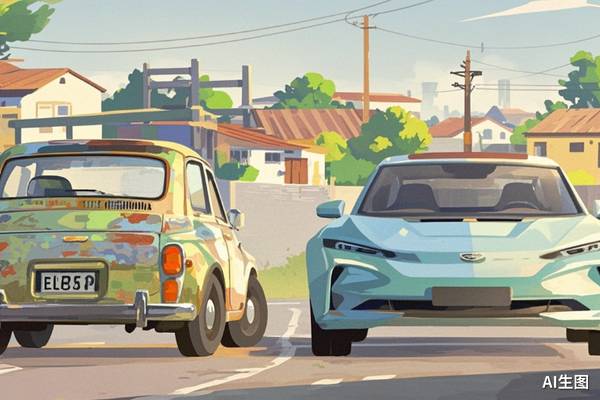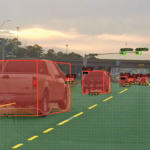The sinking market doesn’t have a smooth-sailing script. The mini-cars that once dominated the streets are quietly disappearing.
During this National Day holiday, I returned to an 18th-tier township in Chaoshan. An obvious change is that the mini-electric cars like Wuling Hongguang MINIEV and Chery QQ Ice Cream, which were everywhere in previous years, are now hard to find.
A friend who works in car sales in my hometown told me that during this National Day, the sales of new energy vehicles in the county increased by nearly 70% year-on-year, while the proportion of mini-cars dropped sharply from 45% in the same period last year to 12%.
Instead, new domestic car brands with distinct designs, such as Xiaomi SU7 and the new XPeng P7, are taking their place. Occasionally, high-end models like Yangwang U8 and Wenjie M9, which are priced over 400,000 yuan, can be seen driving smoothly on the roads.
Image source: Filmed by Electric Vehicle Express
This strong contrast makes people can’t help but wonder: Why have the mini-cars, once known as the “township wonders”, suddenly lost their appeal? And what has made high-end new energy vehicles popular in 18th-tier small cities?
For a long time, mini-cars were the “travel wonders” in lower-tier cities and were highly favored. The price factor was the key to their popularity. At that time, in my hometown, it was almost a situation of “where there is a road, there is a mini-car”.
Take the Wuling Hongguang MINIEV for example. With an initial starting price of 28,800 yuan, many families with low incomes in lower-tier cities could easily own a car, achieving a leap in travel from scratch. This greatly lowered the threshold for car purchase, making cars no longer an unattainable luxury.
Image source: Wuling Hongguang
However, the popularity of mini-cars didn’t last long.
Data from the Passenger Car Association shows that in 2021, the sales volume of A00-class pure electric vehicles was 990,000, accounting for 36.1% of the sales volume of pure electric vehicles, making it the largest single segment. In 2022, the share of this segment began to shrink to 27%. In 2023, the cumulative retail sales of the mini-car market further decreased to 692,000, a year-on-year decrease of 27.9%, a reduction of 267,000 compared to 2022.
In 2024 and 2025, there was no obvious improvement. Looking at the mini-car market, compared with the fierce competition in previous years, now only BYD Seagull and Geely Xingyuan are left competing for the top positions.
Image source: BYD
Are the people’s mini-cars now being disliked by the people?
There are two main factors. On the one hand, car manufacturers are no longer willing to enter the mini-car market. On the other hand, consumers have better choices.
From the strategic perspective of car manufacturers, the decline of the mini-car market in recent years is essentially an active “strategic contraction”. Once upon a time, the discontinuation of models like ORA Black Cat and White Cat sent a clear signal: beneath the seemingly prosperous sales volume, the A00-class pure electric segment is facing an insurmountable profit dilemma.
Ultimately, the competition in the pure electric small car market is an extremely cruel cost war.
Dong Yudong, the CEO of the ORA brand, once publicly stated that during the industry cultivation period, mini-cars were a powerful tool to promote popularization. However, when multiple factors such as the soaring raw material prices and the reduction of national subsidies were combined, the inherent low-cost model became unsustainable, and losses became the norm in the industry.
Image source: Great Wall ORA
Even Wuling, known as the “maker of miracle cars” with strong cost control ability, couldn’t escape this dilemma. The absolute dominance in the mini-car market brought it a huge sales volume, but it couldn’t be translated into substantial profits.
The semi-annual financial report of SAIC Group in 2023 showed that with the scale effect of selling 520,000 cars, SAIC-GM-Wuling’s net profit attributable to the parent company plummeted by 88.5% year-on-year. After calculation, the average profit per car sold was only about 77.3 yuan.
From the consumers’ perspective, with the rapid development of new energy technology, more new energy models such as small SUVs and sedans have joined the price war. They are affordable and have more advantages than mini-cars in terms of space, range, and configuration. Consumers can buy a car with a larger space, longer range, and richer configuration by spending a little more money, so naturally, they will shift their attention from mini-cars.
Secondly, the shortcoming in safety performance is also an important factor for the decline of mini-cars.
Due to size and cost limitations, mini-cars often have fewer safety configurations than larger vehicles. The mid and low – end models may lack key safety features such as airbags and electronic stability control systems. In the event of a traffic accident, their ability to protect passengers is weaker, which makes more and more safety-conscious consumers hesitate.
However, as mini-cars are disappearing, models with higher positioning and higher prices, such as Xiaomi YU7, XPeng P7, Wenjie M9, and Yangwang U8, are starting to appear frequently on township streets.
To understand the reasons, we need to look a little further.
First, we need to break a stereotype: lower-tier cities don’t lack consumption ability. Instead, the consumption scenarios were limited in the past, and people “had money but nowhere to spend it”.
When I went back to my hometown during the National Day and caught up with a friend, I really felt the consumption power of the “sinking market”. My friend, who has a monthly salary of 5,000 yuan, shows such decisiveness and even freedom in consumption that I, a worker in a first-tier city with a higher income but less courage to spend money, felt envious and a bit sad.
He doesn’t come from a wealthy family, but he lives a fulfilling life: he pursues instant gratification and values the quality of life. This is not an isolated case but a common phenomenon among contemporary county youths. They have money and leisure time, and they are an underestimated “hidden consumption force”.
Image source: Filmed by Electric Vehicle Express
Secondly, in the past two years, with the sinking of capital, some young people have returned to their hometowns to work and start businesses. From some live – streamers and YouTubers on Douyin, Kuaishou, and Bilibili, we can see that not all of them work in first-tier cities. Many small cities in Guangdong, such as Yangjiang and Chaoshan, have also produced a lot of internet celebrities.
That is to say, “escaping from big cities like Beijing, Shanghai, and Guangzhou” has changed from a slogan to a real action.
We can also see some signs from the data:
According to the “Insight Report on the Small – City Car Market in the Automotive Industry (2025 Edition)” released by the Yiche Research Institute, it mentions that “the sinking of capital and the return of the population are boosting the small – city car market”.
Data shows that since 2022, the proportion of the elderly in the small – city car market has rapidly increased to 6.37%, approaching 10% in 2024. The proportion of the youth showed signs of stabilizing in 2024, remaining at around 30%. As the proportions of the elderly and the youth increased, the proportion of the small – city car market in the overall market also started to rebound. In the first quarter of 2025, it rose to 44.66%.
These two groups of young people, even when they return to their hometowns, tend to choose new – force models with personalized and self – gratifying features when buying cars.
Meanwhile, another force that cannot be ignored is strengthening this trend – the wave of retired “silver – haired” people returning to their hometowns. Different from the youth who are still exploring their career paths, the decision of these people born in the 1960s and 1970s to return to their hometowns is often more decisive and thorough. They return to their hometowns with decades of savings, aiming to live a stable and comfortable life.
This group has different consumption characteristics. They have a more generous car – buying budget and have clear and mature requirements for the space comfort, safety, and technological configuration (such as intelligent driving assistance) of vehicles. Therefore, the middle – aged and elderly retired group with strong consumption power and clear needs is quickly becoming a more potential new blue ocean in the lower – tier city car market.
Take my father as an example. Even as a 60 – year – old in an 18th – tier small town, he tends to choose new – force models like Wenjie M7, Denza N8L, and Lynk & Co 900 when buying a car. His core requirements are intelligent driving and space.
Image source: Screenshot of the WeChat of an editor from Electric Vehicle Express
This is why in small towns, we can see both models like YU7 and P7 that attract young people and models like Wenjie M9 and Yangwang U8 that appeal to middle – aged people.
In this context, the stage of new energy vehicles has extended from the prosperous first – and second – tier cities to the fourth – and fifth – tier cities.
To be honest, the new energy vehicle market in first – and second – tier cities has gradually changed from a “blue ocean” to a “red ocean”. As the growth ceiling is becoming visible, the vast lower – tier market has naturally become a “must – compete” area for car manufacturers to ensure future growth and even determine their survival.
According to data from the China Electric Vehicle 100 – Person Forum, in just four years (2020 – 2024), the sales volume of new energy vehicles in third – tier and lower cities soared from less than 500,000 to over 5 million. Its growth rate has continuously outpaced the overall market, and the market share has increased significantly from 32.1% to 47.1%, almost accounting for half of the national new energy market. This means that whoever wins the “township youths” wins the market.
Facing this rapidly emerging new market, car manufacturers’ strategies have been upgraded from “tentative layout” a few years ago to “strategic all – out attack”.
In some townships, BYD 4S stores are springing up. In a small place where there is only one McDonald’s, there are already two BYD 4S stores.
Image source: BYD
Li Auto has launched the “Hundred – City Starry Sky Plan”, targeting cities below the third – tier. In Zigong, a fifth – tier city in Sichuan, Li Auto captured 28% of the market share for cars priced over 200,000 yuan in just half a year. By opening more stores and holding various offline activities in these cities, it allows more urban and rural consumers to understand and experience Li Auto’s products and services, thereby increasing brand awareness and market share.
NIO is committed to solving the shortcoming of insufficient charging infrastructure for new energy vehicles in lower – tier cities through the construction of the “Battery – Swap County – to – County Connectivity” energy – replenishment network, improving the user experience in urban and rural areas.
It can be said that from 2025 – 2026, whoever can establish a foothold in small cities will have a chance to win the overall market.
Based on the observations during the National Day return to my hometown, Electric Vehicle Express concludes: The lower – tier market is no longer a “supporting role” for new energy vehicles but the main battlefield that determines the outcome. The once – ubiquitous mini – cars are
该文观点仅代表作者本人,36氪平台仅提供信息存储空间服务。
36kr Europe (eu.36kr.com) delivers global business and markets news, data, analysis, and video to the world, dedicated to building value and providing business service for companies’ global expansion.
© 2024 36kr.com. All rights reserved.




















